
22 Apr World Earth Day – Building A Carbon-Free Future!
World Earth Day 2022
We owe the rightful celebration of Earth Day to the environmental movements that gained momentum in the 1970s which have compelled action on the policy and behavior front. It all goes back to when 20 million Americans mobilized a march “to demonstrate against the impacts of 150 years of industrial development which had left a growing legacy of serious human health impacts.”
As per all plying climate treaties, the most important being The Paris Agreement, CO2 emissions must be eliminated by 2040 to keep our planet habitable at 1.5 degrees Celsius. The buildings and real estate sector need to seriously buckle up because of the total emissions, building operations are responsible for 28%, and materials and construction another 11%! It is also estimated that 2/3rd of these buildings will continue to exist come 2040, making retro-commissioning, re-commissioning, or commissioning a necessity.
The pressing need has been realized and addressed well in the Climate Mobilization Act, which is a comprehensive piece of legislation enacted in May of 2019. It was designed to reduce New York City’s overall greenhouse gas emissions by 40% (2030), and up to 80% (2050), but ideally to achieve net-zero by 2050.
To facilitate the ambitious goal, a series of bills were passed. The centerpiece of the legislation is Local Law 97, among other laws. This is the part of the bill which specifically mandates what the greenhouse emissions limits are for each building type. More than 50,000 buildings will get impacted overall. In 2024, about 25% of those will be directly affected by the carbon emissions limit and practically every building in NYC by 2030. A typical commercial office building in midtown Manhattan of 250,000 sq. ft. producing over 1.5 tons of stipulated carbon limits will be looking at a fine of over $100,000, and progressively for each year that follows.
Non-compliance is tied to harsh financial penalties that get worse over time. For example, a 1 million sq. ft. commercial office building that is just 10% above the 2024 carbon limit will be looking at a penalty of about $230,000 every year till 2029. From 2029 to 2030, the permissible carbon limit will be further reduced by a staggering 50% equating to a $1,200,000 penalty every year till 2034.
The (various) commissioning needs mentioned earlier are tackled by the Local Laws 84 & 87 respectively.
NYC Local Law 84 : First introduced in 2009 with NYC Local Law 84, Benchmarking mandates that buildings over 50,000 square feet report their annual energy usage and water consumption. The year 2016 witnessed an extension of it under Local Law 133 to also include properties with an area greater than 25,000 square feet but lesser than 50,000 square feet. The two laws serve in tandem to increase the transparency vis-à-vis building’s consumption patterns with an ultimate goal of achieving optimum energy efficiency.
NYC Local Law 87 : An energy audit indicates the energy efficiency of a building after conducting an inspection, survey & analysis, along with curating a report of energy flows to improve the energy efficiency. It involves studying the base building systems- building envelope, HVAC (heating, ventilation, and air-conditioning), conveying systems, domestic hot water systems, electrical and lighting systems, etc. Retro-commissioning however, is a thorough evaluation of how optimally HVAC and lighting controls are actually functioning.
NYC Local Law 87 applies to buildings larger than 50,000 square feet and mandates for them to file an ‘Energy Efficiency Report’ with the Department of Buildings, which will contain details of the energy audit results & retro-commissioning measures- both, required by the law and deemed penal in cases of non-compliance
In the face of the pandemic, many had begun to question the relevance of trophy office buildings and skyscrapers. NYC’s skyline is more than just the city’s USP, it’s characteristic as the symbol of Manhattan’s position as one of the busiest business consolidations. The iconic skyscrapers are in fact causing immense damage to the environment, and consequently to people’s health. Green Biz reports that New York City is responsible for the consumption of more fossil fuels in the residential and commercial real estate regions as opposed to any other region in any other state. Fuel combustion results in roughly 2,000 premature deaths and health impacts that can be quantified at $21.7 billion in 2017.
In addition to Local Law 97, the following laws have been passed under CMA to ensure a holistic action.
1. Local Law 92 & 94: these laws mandate green architecture on all new construction or renovation of a certain scale in NYC, in the form of green roofs, wind power, and solar PV.
2. Local law 95: the law enables better-suited labels. It guides in adjusting metrics that are used for letter grades to assess a building’s energy performance.
3. Local law 96 – PACE: The law helps establish clean energy financial tools for building owners by laying the groundwork for Property Assessed Clean Energy Program (PACE). The program is a way of financing retrofits for the buildings to be able to comply with LL97.
4. Local Law 98: The law obligates the Department of Buildings to include wind energy generation in its toolbox of renewable energy technologies.
Navigating the compliance landscape can be extremely complex. Seeking expert advice, therefore, is the most sought-out way to go about it with regard to cost-effectiveness, business longevity, and time efficiency. We, The Cotocon Group, have a proven history of providing compliance, engineering, and commissioning services in New York City to building owners. Our highly skilled team ensures building owners meet all the requirements from planning, compliance, scheduling, conducting energy audits, and retro-commissioning to generating and submitting the Energy Efficiency Report within the deadline. We will demonstrate that the greatest return on investment for building owners is investing in energy efficiency – all implemented in a way that guaranteed an increase in your property value.
